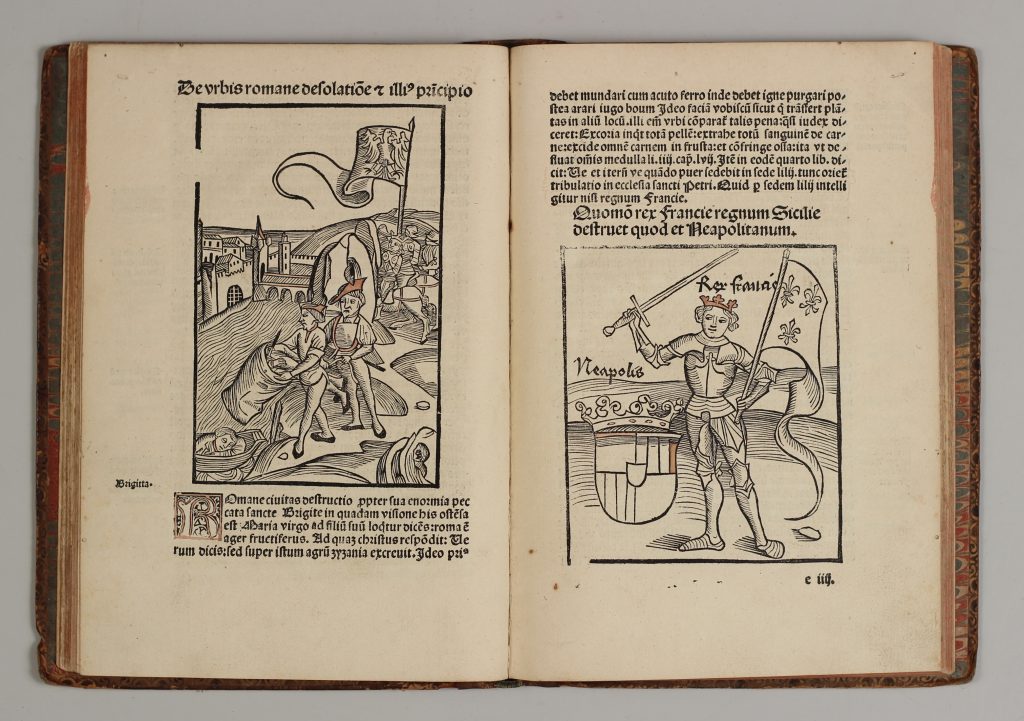Methodius, ps.
Revelationes divinae … Basel 1500 [sold]
Revelationes divinae a sanctis angelis factae de principio mundi. [Add: Wolfangus Aytinger. Tractatus super Methodium]. [Ed. Sebastian Brant]. — Finit Basilee Michaelem Furter opera et vigilantia Sebastiani Brant. Anno. M.ccccc. xvi. Kal. Martij.
[Basel, M. Furter, 14. Febr. 1500.]
4to (205 x 141 mm).
a-g8 h-i6: (68) leaves.
61 woodcuts, a few with coloring in red, a few underlinings in red. Three or four tiny wormholes in the margins. Recent limp vellum.
ISTC im00525000.
¶ On the strange and difficult text of ps.-Methodius originally written in the Syriac language in the second half of the seventh century I quote a few lines from B. McGinn, Visions of the End. Apocalyptic Traditions in the Middle Ages, pp. 70ff.:
„The crown of Eastern Christian apocalyptic literature is the treatise attributed to Methodius of Patara, a martyr bishop who died in the early fourth century. After the Book of Daniel and the Revelation of John it was among the most widespread of medieval apocalyptic texts … [it is] a politico-religious manifesto, rejecting every kind of defeatism or collaboration with the Moslems, warning against reliance on the weak and distant ruler of Ethiopia as a will-o-the wisp, calling for war against the conquerors, and preaching that salvation from the Moslem yoke could come only from one source, the most powerful Christian monarch of the time, the basileus at Byzantium …
The Relevations of Pseud-Methodius is the earliest surviving witness to the legend of the Last World Emperor … Like many great apocalypses the Pseudo-Methodius was born in the midst of crisis. In the Revelations for the first time a foe worthy of the fully formed imperial apocalyptic myth steps upon the scene …
The influence of the Pseudo-Methodius in the West was immense. The text itself was later translated into a number of vernacular literatures, and was printed early and often. The use of the text in the twelth and thirteenth centuries, the confrontation with Islam, and the threat of the Mongol invasions gives sufficient evidence of its paramount importance.“
The second author: Wolfgang Aytinger, ca. 1465-1515, from Augsburg, calls himself „juris utriusque promotus“, „artium magister“ and „Clericus“; red proofs for the Augsburg printers Oehlin, Nadler, and for Froschauer. His edition of ps.-Methodius and its treatise is Aytinger’s only publication. In the treatise Aytinger cites the relevant literature from Joachim di Fiore to Bridget of Sweden, from Vincenz Ferrer to Johannes Lichtenberger, and many more.
After the fall of Constantinople in 1453 the visions of the end of the Western Christianity flourished and Aytinger brings this and the need for reform of the Church together in his tract, the hoped and expected „destructio Turciae“ and the „purgatio et reformatio ecclesiae“.
The editor of the book is Sebastian Brant (1457-1521), humanist and satirist from Strasbourg, who held the chair of jurisprudence in Basel; famous as author of Das Narrrenschiff / Ship of Fools, first published at Basel in 1494. The preface by Brant (a1b and a2a) is addressed to Johannes Meder, the Basel Franciscan who in 1495 and 1497 had published a Quadragesimale at Basel printed also by Michael Furter. Sometime in late 1496 or early 1497 Meder suggested to Brant a new edition of ps.-Methodius. But unlike the existing editions it should be an illustrated edition, a „picturata editio“.
In his preface Brant refers to Meder’s request. The picture, says Brant, is absolutely necessary for the understanding of the revelation of Methodius by a broader „readership“*. What the written word means to those who can read, the image does for those who can not (idiotae, and ignorantes). In the image, the ignorant see what they should understand, and in it, those who are ignorant of the scripture can „read“.
In other words: the book had two groups of readership: one could read and understand the Latin text, a second who could „read“ the illustration only. To the first group the illustrations have no additional information but are visualizations of what they have read; to the second the illustrations are a text which is understood by the help of oral instructions. (In difference to the „fall of the angels“, „Adam and Eve picking the apple“ or „Gog and Magog“ most woodcuts do not understand by itself, but need explanation even for the then „reader“.)
Whereas the reader of the text did not need others for understanding, and therefore could read in a private situation being alone in a room, those of the second group had to „read“ the woodcuts in a group of at least two; it must have been a kind of „public“ reading with the oral explanation of the woodcuts – explanations of course in the vernacular. You may call the book a Methodius pauperum.
Be it as it may – Brant’s note on the woodcuts and their function is surely one of the earliest if not the earliest of its kind.
––––––––––––––––––
* … picturas rerum gestarum esse necessarias. Nam quod legentibus scriptura hoc et idiotis praestat pictura cernentibus. Quia in ipsa ignorantes vident quid sequi debeant. In ipsa legunt qui litteras nesciunt. Unde et praecipue imperitis pro lectione pictura est. Tuo igitur iussu deo amabilis pater tuoque suasu hanc quam coram cernis popularem subii provinciam. Tabulas utcumque sculpendas ordinavi: quo facilius spiritus prophetici multis innotescat vaticinium … (leaf a1b)






